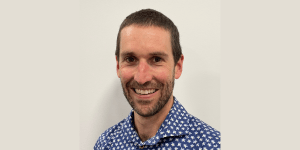1:30min
 A joint collaboration between optometry and ophthalmology in Northern Tasmania is proving to be effective in enhancing glaucoma care and improving patient outcomes.
A joint collaboration between optometry and ophthalmology in Northern Tasmania is proving to be effective in enhancing glaucoma care and improving patient outcomes.
After surveying local optometrists and ophthalmologists across Tasmania, with the intention of gauging perceptions and attitudes towards glaucoma co-management, optometrist Damon Hannay identified a strong mutual interest in shared care arrangements among both professions.
With support from the two local ophthalmology clinics in his area, he developed a structured collaborative framework to streamline how patients with glaucoma receive care. The framework allows practitioners to clinically identify which cases of glaucoma should be ophthalmology-led or optometry-led, or involve a collaborative approach. The framework also outlines the shared care arrangements between ophthalmology and optometry, ensuring a smooth and patient-centric approach to glaucoma management.
As a member of Optometry Australia’s Community of Practice and Education (COPE) group on glaucoma care, Damon has a personal interest in improving collaborative arrangements, and is passionate about making them more definitive, effective and individualised to location. He also recently participated in OA’s Collaborative Care Symposium, contributing to discussions on embedding collaborative models into mainstream healthcare.
Q: Why did you conduct the survey, and what were the main results?
Damon: We conducted the survey to get an understanding of the current perceptions and practices in relation to glaucoma management. Given Australia’s ageing population, the incidence of glaucoma is expected to increase. With the limited public options available for glaucoma patients, it was important for us to understand how we could best collaborate to optimise patient care in Northern Tasmania. We also wanted to identify the barriers that were hindering successful glaucoma co-management, and then use this data to develop resources to improve collaborative glaucoma care between optometry and ophthalmology.
The results indicated that the majority of optometrists were interested in participating in glaucoma co-management, with most already doing so in some capacity. Among the ophthalmologists, results showed that all were currently either actively engaging in co-management, or doing so on the request of the optometrist or patient.
There were a few barriers that needed to be addressed; for optometrists, the biggest issues were the inability to easily share relevant imaging and knowing how and when to get involved. There were also other concerns, such as having the necessary equipment, and some optometrists noted timing and financial constraints, expressing that the cost of providing glaucoma care is not covered by Medicare. For ophthalmologists, barriers included the lack of clarity around which optometry practices have access to what equipment, and understanding how progression might be tracked if care shared across different instrumentation.
Q: Can you explain the framework in more detail?
Damon: The glaucoma collaborative care framework offers a systematic approach to classifying glaucoma patients, making it clear whether their treatment might be best suited towards ophthalmology-led or optometry-led care. There is, however, some deliberate flexibility built into the agreement for cases of moderate glaucoma catering to the different confidence levels of the practitioners involved. Essentially, the better the professional relationship and the more frequent the framework is utilised, the more care will be shifted to the optometrist involved.
The framework also outlines the expected initial referral requirements; the obligations for participating optometrists, including access to equipment; sharing of data/imaging and reports; follow-up visits and optometry decision trees.
In June this year, we presented the framework to the optometry community in Northern Tasmania with support of the local ophthalmologist team and the intention to commence formal implementation. We had around 30 attendees at the meeting – this represents 100% of ophthalmologists and 90% of optometrists in Launceston/Devonport.
Q: What were the outcomes?
Damon: Since the meeting in June, we now have a formal agreement in place between my practice in Launceston and both my local ophthalmology clinics.
We also made the framework available to other optometry practices to embrace if they wished. Some practices have taken steps to do this, and we’ve created a register of interested optometry practices. There are a few requirements; to be on the register, the practice needs to have access to a minimum set of equipment, as well as have the interest and self-identified skills to be involved.
Q: How has the framework improved care for glaucoma patients?
Damon: Since the meeting, I’ve witnessed an increase in collaborative glaucoma care between optometrists within my practice and ophthalmologists in the area. This expands beyond just new referrals – it also involves ophthalmologists proactively shifting patient care when appropriate from their practice to ours. Patients with glaucoma have benefited from this model through reduced costs and shorter wait times to see ophthalmologists; those with low-risk glaucoma living in lower socioeconomic areas now have a public service option that is available to them. At the same time, patients who require urgent access to ophthalmology services can now be prioritised.
Both professions have also actively embraced using the framework labels such as ‘optometry-led care’, showing that everyone is feeling more confident in utilising the framework.
Q: What are your next steps?
Damon: Currently, I am working with some of the local ophthalmologists to ensure the framework is being utilised correctly and that it remains appropriate. We’re also trying to take steps to improve the ability to monitor patients being managed collaboratively. This would potentially allow for some degree of self-audit, as well as support in communicating with patients regarding their upcoming reviews.
I am hopeful (and am actively working towards) finding a software platform that will help document these patients and allow us to better communicate among ourselves and with the patients (regarding reviews) when being managed collaboratively.
Are you interested in collaborative care?
Michael Yapp has recently joined Optometry Australia focusing on collaborative care programs. If you would like to discuss existing or potential future options to see if Optometry Australia can assist, please contact him at m.yapp@optometry.org.au.
Tagged as: Collaborative care